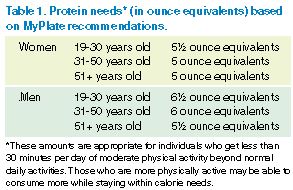Nourish Your Muscles (FN1678, Reviewed Feb. 2019)
Availability: Web only
Test Your Knowledge
1. Our body needs protein for many reasons. Which of the following is/are functions of protein in the body?
a. Promoting a healthy immune system
b. Providing energy
c. Promoting wound healing
d. All of these are functions of protein
2. About how much protein does a 3-ounce serving of meat, poultry or fish contain?
a. 5 grams
b. 15 grams
c. 20 grams
d. 40 grams
3. What are the primary fuels for muscles?
a. Protein and carbohydrate
b. Fat and protein
c. Fat and carbohydrate
d. Fat and water
Answers: 1. d; 2. c; 3. a
Why is protein so important to your diet?
Protein is a building block for bones, muscle, skin and blood.
- Adequate amounts of protein help heal wounds faster.
- Adequate protein helps fight infection.
- Protein provides the body with energy.
- Protein helps maintain muscle mass.
- Protein foods provide B vitamins, iron, zinc and magnesium.
5 signs you are not getting enough protein.
- You’re tired when you shouldn’t be.
- You feel weak, and simple tasks may become difficult.
- Your skin has become more fragile.
- Recovering from an injury, illness or wound takes longer than expected.
- You have swelling in your legs.
How much protein do you need?
Protein needs are calculated as a percentage of your total calorie intake. Protein needs can be shown in “grams” or ounce equivalents. Here’s how to calculate protein needs in grams:
Example: If you eat 2,000 calories a day, 10 to 20 percent of those calories should come from protein.
1. Using 20 percent of calories from protein, we do this calculation: 0.2 x 2,000 = 400 calories
2. Protein contains 4 calories per gram. 400 calories ÷ 4 calories/gram = 100 grams of protein
3. Divide protein into meals/snacks throughout the day. 100 grams of protein ÷ 3 meals/day = 30 to 35 grams protein per meal, on average
What is a protein food?
According to MyPlate, meat, poultry, seafood, beans and peas, eggs, processed soy products, nuts and seeds are considered part of the Protein Foods Group. Protein needs are shown as “ounce equivalents” on MyPlate.
- One ounce equivalent = 1 ounce of meat, poultry or fish (about the size of four dice), ¼ cup cooked beans (about the size of a golf ball), 1 egg, 1 tablespoon of peanut butter or ½ ounce of nuts or seeds

Remember:
- Excess protein above calorie needs is likely to contribute to weight gain.
- Dollar for dollar, whole foods are a better buy than supplements because whole foods contain a larger variety of nutrients and other needed ingredients such as antioxidants.
- No conclusive research shows that concentrated protein sources (such as protein powders) are more beneficial than whole-food sources.
Enjoy different kinds of protein throughout the day
- Eggs (6 grams protein / large egg)
- Meat, poultry and fish (about 21 grams protein /3-ounce piece – about the size of a deck of cards)
- Milk and milk products (8 grams protein /1 cup milk)
- Nuts and seeds (about 5 grams protein /1 ounce raw nuts – a small handful)
- Tofu (13 grams protein/½ cup tofu)
- Legumes, dry beans and peas (8 grams protein /½ cup beans)
Healthful Protein-rich Snack Ideas
- Try Greek yogurt, which contains 11 to 14 grams of protein, depending on the brand.
- Try hummus (chickpea dip) or a bean dip with whole-wheat crackers.
- Enjoy a handful of mixed nuts, which will give you about 5 grams of protein along with healthy fats that are good for your heart.
Nourish Your Muscles Checklist
- Eat a healthful diet, including adequate protein.
- Eat a variety of carbohydrates, including whole grains, fruits and vegetables.
- Stay hydrated.
- Stay physically active, using resistance training to maintain muscle strength.
For more information about nutrition and fitness, visit these websites:
U.S. Department of Agriculture with a wide range of nutrition resources.
Reviewed February 2019

